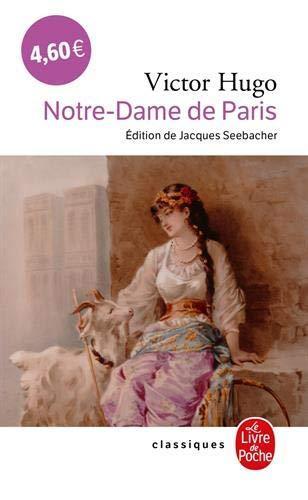730 Seiten
Sprache: French
Am 1999 von Le Livre de poche veröffentlicht.

730 Seiten
Sprache: French
Am 1999 von Le Livre de poche veröffentlicht.
The Hunchback of Notre-Dame (French: Notre-Dame de Paris, lit. 'Our Lady of Paris', originally titled Notre-Dame de Paris. 1482) is a French Gothic novel by Victor Hugo, published in 1831. The title refers to the Notre-Dame Cathedral, which features prominently throughout the novel. It focuses on the unfortunate story of Quasimodo, the Roma street dancer Esmeralda and Quasimodo's guardian, the Archdeacon Claude Frollo, in 15th-century Paris. All its elements—the Renaissance setting, impossible love affairs, and marginalized characters—make the work a model of the literary themes of Romanticism. The novel is considered a classic of French literature and has been adapted repeatedly for film, stage and television. Some prominent examples include a 1923 silent film with Lon Chaney, a 1939 sound film with Charles Laughton, a 1956 film with Anthony Quinn, and a 1996 Disney animated film with Tom Hulce. Written during a time of cultural upheaval, the novel champions historical …
The Hunchback of Notre-Dame (French: Notre-Dame de Paris, lit. 'Our Lady of Paris', originally titled Notre-Dame de Paris. 1482) is a French Gothic novel by Victor Hugo, published in 1831. The title refers to the Notre-Dame Cathedral, which features prominently throughout the novel. It focuses on the unfortunate story of Quasimodo, the Roma street dancer Esmeralda and Quasimodo's guardian, the Archdeacon Claude Frollo, in 15th-century Paris. All its elements—the Renaissance setting, impossible love affairs, and marginalized characters—make the work a model of the literary themes of Romanticism. The novel is considered a classic of French literature and has been adapted repeatedly for film, stage and television. Some prominent examples include a 1923 silent film with Lon Chaney, a 1939 sound film with Charles Laughton, a 1956 film with Anthony Quinn, and a 1996 Disney animated film with Tom Hulce. Written during a time of cultural upheaval, the novel champions historical preservation. Hugo solidified Notre-Dame de Paris as a national icon, arguing for the preservation of Gothic architecture as an element of France's cultural heritage.